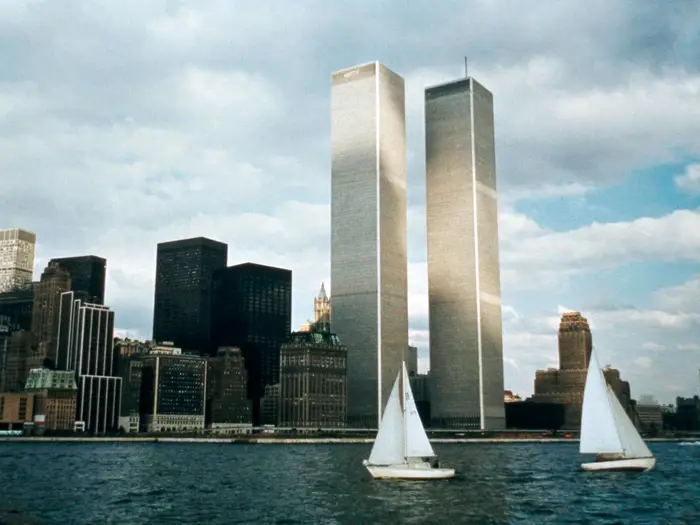Introduction
The Twin Towers, part of the World Trade Center complex in New York City, were more than just architectural landmarks; they symbolized the aspirations and resilience of New York and the nation. Their rise, destruction, and the subsequent rebuilding efforts encapsulate a story of ambition, tragedy, and an enduring spirit of recovery.
1. The Rise of the Twin Towers
A. Vision and Design
- Conceptualization: The idea for the World Trade Center emerged in the 1960s, driven by David Rockefeller’s vision to create a global trade hub. The design was conceived to reflect New York City’s role as an economic powerhouse.
- Architectural Design: Designed by architect Minoru Yamasaki, the Twin Towers were distinctive for their sheer height and innovative structural system. Standing at 110 stories each, they were among the tallest buildings in the world at their completion.
B. Construction
- Timeline: Construction of the Twin Towers began in 1966, and the North Tower was completed in 1970, followed by the South Tower in 1971.
- Engineering Feats: The towers employed a tubular steel structure, which allowed for open floor plans and a dramatic increase in usable space. This design also contributed to their resilience against high winds and seismic activity.
C. Impact on New York City
- Economic and Cultural Hub: The Twin Towers quickly became symbols of New York’s economic might, housing major financial institutions and becoming a central part of the city’s skyline.
- Tourist Attraction: The observation decks offered panoramic views of the city, attracting millions of visitors annually and contributing to New York’s cultural cachet.
2. The September 11 Attacks
A. The Attacks
- Events of 9/11: On September 11, 2001, terrorists hijacked two planes and crashed them into the Twin Towers. The North Tower was hit at 8:46 AM and the South Tower at 9:03 AM.
- Collapse: Both towers collapsed within hours of the impacts, at 9:59 AM and 10:28 AM, respectively, due to the extensive damage and fires that weakened their structural integrity.
B. Immediate Impact
- Casualties: The attacks resulted in the deaths of approximately 2,977 people, including passengers, first responders, and workers in the towers. The tragedy also left thousands injured and caused substantial economic and emotional damage.
C. National and Global Reactions
- Shock and Mourning: The attacks elicited global shock and solidarity. New Yorkers, Americans, and people around the world mourned the loss and grappled with the enormity of the tragedy.
- Security and Policy Changes: The attacks led to significant changes in U.S. security policies, including the implementation of the Patriot Act and increased airport security measures.

3. Symbolism and Resilience
A. Symbol of Resilience
- Rebuilding Efforts: In the aftermath, the focus shifted to rebuilding and honoring the victims. The site of the Twin Towers, known as Ground Zero, became a focal point for both mourning and hope.
- Freedom Tower (One World Trade Center): The new One World Trade Center, completed in 2013, stands as a symbol of resilience and renewal. Its design incorporates security features and offers breathtaking views, while its height and architecture pay tribute to the original Twin Towers.
B. Memorials and Tributes
- 9/11 Memorial and Museum: Opened in 2011, the memorial and museum at the World Trade Center site commemorate the lives lost and the events of September 11. The twin reflecting pools, located in the footprints of the original towers, and the museum exhibit provide a space for remembrance and reflection.
- Tributes Across the City: Various memorials, including plaques and dedicated spaces in New York City, honor the legacy of the Twin Towers and the resilience of the city’s people.
4. Cultural and Historical Impact
A. Media and Literature
- Documentaries and Films: The Twin Towers have been the subject of numerous documentaries and films that explore their history, the attacks, and the aftermath. Notable examples include “World Trade Center” and “9/11” by filmmaker James Hanlon.
- Literature: Books and essays by various authors have examined the impact of the Twin Towers on American culture, the emotional response to the attacks, and the broader implications for global security and geopolitics.
B. Influence on Architecture
- Design Innovations: The collapse of the Twin Towers led to advancements in building safety and design, including improvements in fire resistance, structural integrity, and emergency response protocols.
- Global Architectural Dialogue: The towers’ design and subsequent events have influenced architectural discussions worldwide, contributing to a broader understanding of urban resilience and disaster preparedness.
5. Legacy and Future
A. Educational Programs
- Public Education: Efforts to educate future generations about the Twin Towers, the attacks, and their implications include educational programs at the 9/11 Memorial Museum and various school initiatives.
B. Ongoing Reflection
- Cultural Memory: The Twin Towers remain a powerful symbol of both the heights of human achievement and the depths of human tragedy. Their story continues to be a subject of reflection, ensuring that the lessons learned are passed on.
Conclusion
The Twin Towers stand as a potent symbol of New York City’s resilience and the broader human spirit. Their rise, destruction, and the subsequent rebuilding efforts reflect a narrative of ambition, tragedy, and enduring hope. As a symbol of both the challenges faced and the strength demonstrated, the Twin Towers continue to inspire and remind us of the importance of resilience in the face of adversity.
Further Reading and Resources
- Books: “The World Trade Center: The History and Legacy of the Twin Towers” by Charles M. Sennott, and “The Twin Towers: A Memoir of September 11th” by Peter J. Johnson.
- Documentaries: “9/11” (2002) by James Hanlon, and “The Falling Man” (2006) by Henry Singer.
- Websites: 9/11 Memorial & Museum, and the official World Trade Center site for information on the current developments and historical context.



